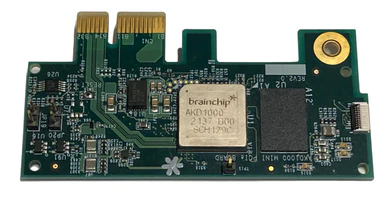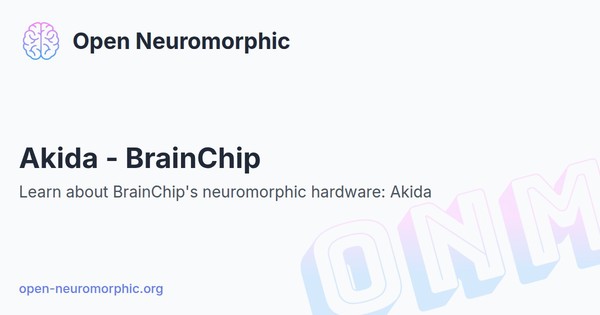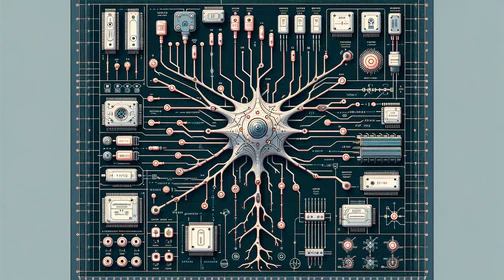BrainChip's Akida is an ultra-low-power neuromorphic processor inspired by the brain's neural architecture. It accelerates complex AI at the edge through event-based processing, on-chip learning abilities, and support for advanced neural networks like CNNs, RNNs & custom Temporal Event-based Nets.
Developed By:
Overview
Inspired by the human brain’s neural architecture, Akida aims to deliver high-performance artificial intelligence capabilities at the edge while being extremely energy efficient.
The Akida processor is designed to accelerate neural networks including convolutional neural networks (CNNs), deep neural networks (DNNs), recurrent neural networks (RNNs) and Vision Transformers (ViTs) directly in hardware. A key feature is its support for a novel neural network architecture called Temporal Event-based Neural Nets (TENNs) which are optimized for processing complex time-series data efficiently.
Akida employs an event-based processing approach where computations are only performed when new sensory input is received, dramatically reducing the number of operations. This also enables event-based communication between processor nodes without CPU intervention. The architecture further supports on-chip learning, allowing models to adapt without having to connect to the cloud.
The second generation Akida platform adds capabilities such as support for 8-bit weights/activations, improved vision transformer acceleration, multi-pass sequential processing, and configurable local scratchpads to optimize memory access. It is designed to run larger neural networks across multiple chips while minimizing latency.
The AKD1000 version was released in January 2022 and can be purchased online directly from BrainChip. As yet, the subsequent versions AKD1500 and AKD2000 are not available for purchase, however, the MetaTF SDK has already been updated to reflect the additional capabilities of the AKD2000 chip. This can lead to confusion when training models that will be mapped to the AKD1000 chip due to certain incompatibilities in the API and deprecated functions.
Neurons and synapses
Akida does not support LIF neurons. Instead, it operates similarly to an event camera, converting pixels to events and using Rank Order Coding (ROC) to encode the input. An Akida core can contain tens of thousands of neurons, although the total number of neurons that can be mapped to the hardware varies with the model type.
Synaptic weights can have a width of 1, 2, 4 or 8 bits. However, when creating quantised models, care should be taken that the input layer have the same number of bits as the input data (cf. notes about training below).
The AKD1000 device supports on-chip continual learning for the last layer only. The layer must be FullyConnected, it must have binary weights, and receive binary inputs. As the FullyConnected layer type only exists for Akida 1.0, at this stage it is unclear whether the AKD2000 device would support on-chip learning.
Training
Akida leverages standard machine learning frameworks like TensorFlow and development platforms like Edge Impulse for model training and deployment. BrainChip also provides complementary software tools like MetaTF to optimize models for the Akida hardware. Pre-built Akida-compatible models are also offered through a model zoo.
MetaTF is based on TensorFlow, with additional wrappers (CNN2SNN and quantizeml) for converting ANNs into quantised models that can run on the device.
- quantizeml: A package for quantising, retratining and calibrating Keras models.
- CNN2SNN: A package providing functions for converting quantised ANNs into SNNs.
The training pipeline starts with a regular Keras model using TensorFlow. The Keras model can be trained using a standard backpropagation-based training pipeline, including GPU tensors, optimisers and functions from TensorFlow. Once the Keras model is trained, it can be quantised using functions provided in the SDK.
The resulting quantised model will have a lower accuracy than the original Keras model (sometimes even substantially lower – potentially several dozen percent). The first step towards restoring the original accuracy of the model is weight calibration. As the quantised model maps regular 32- or 64-bit floating-point synaptic weights to a much narrower range of values, the calibration step adjusts the range of densest numerical representation in the quantised model to best match the distribution of values in the training data. A detailed explanation of this process can be found here. After that, the quantised model can be fine-tuned by retraining it using a similar training pipeline as that for the Keras model. Important points to consider during these steps include:
AKD1000 and AKD1500 devices support only Akida 1.0 layer types, of which there is only a limited number. Akida 2.0 layers are much richer, however, at the time of writing the AKD2000 hardware has not yet been released.
The mapping of Keras to Akida layers is not one-to-one. For instance, the Akida convolutional layer corresponds to a Conv2D layer optionally followed by BatchNorm, Pooling and ReLU layers, even though those are not specified in the MetaTF documentation as separate layer types. Therefore, the Keras model can include blocks such as Conv2D -> BatchNorm -> MaxPool -> ReLU -> Dropout.
Many combinations of layers are not supported at least for Akida 1.0 layers. For instance, a
Conv2Dcannot be followed directly by aDenselayer - it is necessary to insert aFlattenlayer between them.It is important to also set the correct number of bits when quantising the input layer to match that of the input data (e.g., 8 bits for 8-bit image input).
If the network fails to train, check the value of the
per_tensor_activationsparameter. It tends to have a strong effect on learning.If the intention is to run a model on hardware, it is worth performing all the conversions and running the resulting network on the Akida chip prior to training in order to ensure that the model is valid.
When evaluating a model on the chip, it is possible to enable built-in power measurement tracking via functions provided in the SDK. This needs to be done at the time of mapping the model to the hardware, after which the power consumption statistics can be retrieved after performing inference.
Applications
Akida targets applications spanning industrial automation, automotive, healthcare, consumer electronics and more. Use cases include predictive maintenance, in-cabin monitoring, vital sign prediction, home automation, surveillance and more. Its efficiency and on-device learning abilities aim to enable a new class of continuously adaptive, secure and private AI implementations at the edge.
Related publications
| Date | Title | Authors | Venue/Source |
|---|---|---|---|
| August 2023 | Low Power & Low Latency Cloud Cover Detection in Small Satellites Using On-board Neuromorphic Processors | Chetan Kadway; Sounak Dey; Arijit Mukherjee; Arpan Pal; Gilles Bézard | IJCNN 2023 |
| August 2023 | Neuromorphic Medical Image Analysis at the Edge | Ebba Bratman, Lucas Dow | Master’s course project |
| October 2022 | Detection of facial emotions using neuromorphic computation | Teodoro Álvarez-Sánchez, Jesús A. Álvarez-Cedillo, Roberto Herrera-Charles | Applications of Digital Image Processing XLV |
| 1998 | Rank Order Coding | S. Thorpe and J. Gautrais | Computational Neuroscience |
Help Us Improve this Guide
Our hardware guide is community-maintained. If you know of a chip we should add, see an error, or have updated information, please let us know by opening an issue on our GitHub repository.





